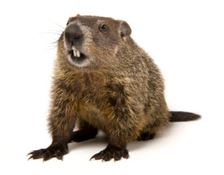Call Today, We'll Be There TODAY!

We have years of experience in the safe handling and quick removal of nuisance Groundhogs from your home or business.
Once removed, we provide a wide range of nuisance Groundhog repair, restoration, and waste cleanup services.
We offer complete Groundhog exclusion services to help ensure your home or business is no longer Groundhog-friendly.

Groundhog
- Nuisance Species
- Groundhog(Marmota monax)
- Common Issues and Problems
- Potentially severe damage to a structures foundation due to digging and burrow location.
- Potential Diseases
- Powassan Virus, Tularemia, Rabies
Nuisance Groundhogs and Groundhog Removal
Groundhogs—also known as woodchucks—are herbivores found in all of Ohio’s 88 counties. They typically live in grasslands, pastures, and woodlands, but quite often take up residence under sheds, porches, decks, and barns. Groundhogs are the largest member of the squirrel family.
Groundhogs are herbivorous and love almost all vegetable matter. Dandelion greens, weeds, grasses, herbs and fruits, and vegetables of all kinds are also enjoyed. However, clover and alfalfa are one of their favorite foods. Adult groundhogs may weigh as much as 14 pounds, but usually weigh between 11 and 12 pounds. Groundhogs typically live 4 to 5 years in the wild.
In the fall, a week or two before going underground for hibernation, the groundhog stops eating and slowly enters hibernation. By mid-October, they will be asleep in their burrows and will hibernate through January or early February, when they awake and begin to prepare for mating. The majority of males come out of their burrows in mid-to-late February; females appear from late February to mid-March.
Mating takes place in late February through March. The period from mid-March through April is a time of ravenous appetite and activity, as groundhogs hurry to mate and raise their young by June. A groundhog mother gives birth to a litter of three to six groundhog kits. At about six weeks of age, the kits become very active and start to follow their mother, eventually leaving the burrow under her protection.
The major problem caused by groundhogs are the large holes they dig and the damage that occurs around walls and foundations. Their holes can be 8-12 inches in size. This animal creates two, sometimes three holes, with a large tunnel system through their burrow that runs from one hole to the next. The groundhog burrow can be as much as 6 feet deep, and 20 feet wide.





